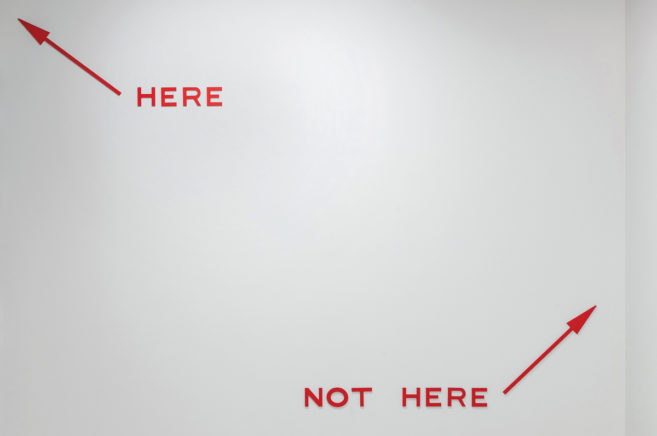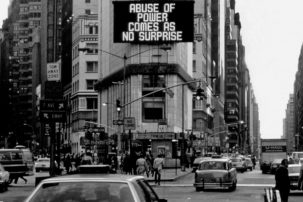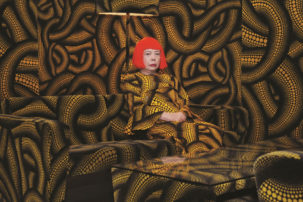Self portrait camouflage by Latifa Laâbissi from Le Triangle on Vimeo.
Let’s talk about cultural appropriation and the art world, and let’s do it without abstraction or recourse to the symbolic. I want to turn instead to the human bodies that comprise “cultures,” and to the cuts and graftings made by “appropriation.”
There are two stories I will tell here to make my point: one a recent example of headdress appropriation in a prominent New York art institution, and the other an encounter from my own experience to help link the theft of “symbols” such as the headdress with theft of land and lives.
Artist Latifa Laâbissi recently performed her piece Self Portrait Camouflage at MoMA PS1 nude, wearing only a faux Plains-style headdress. It was her intention to make a political statement by making herself vulnerable in these symbolic ways: nakedness, headdress. I contend that it was not only her own body she made vulnerable on that stage; she conscripted and claimed unwilling bodies through her use of the headdress as a catch-all stand-in for marginalized peoples.
Laâbissi was invited to MoMA PS1 to perform Self Portrait Camouflage as part of the festival American Realness on January 8, 2017. The performance would be made up of four objects: her own nude body as an Arab-French woman, a French flag to force-feed herself, a text spoken in her mother’s Arabic-inflected French and the bright red headdress. According to the artist, the work was inspired by a “personal urgency to explicitly call out the repression of the dominating colonial powers,”using the French flag and headdress to speak about her own position within France’s colonial relations to her parents’ home of Morocco.
One month before the performance, Seneca choreographer Rosy Simas published a post on her Facebook page criticizing use of the headdress, and of the trope of the sexualized Indigenous woman: “I see a non-Native woman in a fake headdress performing naked. I see a mockery of who Native women are. And I see a stage reserved for whiteness excusing itself from responsibility because it is an international person of color performing this mockery.” Simas pointed to the real, pressing contemporary struggles of Native women who experience violence, go missing or are murdered at increasing rates. She also pointed to the cruel irony of a non-Native artist claiming a cultural object specific to the Sioux peoples at the same moment that the Sioux of Standing Rock had been struggling for land and life against the Dakota Access Pipeline for nearly a year. “Images like this remind those women, remind all of us Native Americans, that we don’t matter and we do not even exist in your eyes,” stresses Simas. Images like these do damage.
Other Indigenous voices joined Simas, and the issue circulated widely on social media. The museum, MoMA PS1, changed its promotional image to hide the headdress, and went ahead with the performance as planned. American Realness, however, dropped the performance from its program and withdrew funding, with festival founder Thomas Benjamin Snapp Pryor issuing an apology. Pryor also announced a “Native American Realness” panel, with Simas and Native Hawaiian choreographer Christopher K. Morgan, to discuss the issue of cultural appropriation. Finally, he invited the public to attend the Indigenous-led art event Umyuangvigkaq: PS122 Long Table and Durational Sewing Bee instead of the Laâbissi performance.
Simas addressed Laâbissi before the performance, and again during the question period after, asking her not to use the headdress any longer. Laâbissi refused, alternately holding up her artistic license and her position as a colonized minority. As Simas told Hyperallergic, “[Laâbissi] could not see that acts of disrespect and oppression can occur even when coming from another colonial context of oppression.”
Indigenous critiques of the performance stressed the damage done by misuse of the headdress. Crow Creek Hunkpati cultural keeper and Dakota/Lakota winyan Janice Bad Moccasin spoke about the significance of the headdress, and her objection to disrespect toward its image: “I strongly asserted the Chief’s headdress is a culturally restricted sacred item that must be worn by the men only who had earned the right to wear such an adornment of honor by their people.” Such critiques have been made on this exact topic before—thoroughly, poignantly, and often. Adrienne Keene, on her critical popular culture blog Native Appropriations, notes how the headdress appropriation repeats itself again and again. Her breakdown of the issue highlights the cultural importance of the headdress, the damage done by its reduction to a stereotype and the underlying fact of ongoing colonial genocide against Indigenous peoples in North America.
Identity politics are a central part of the debate—both Laâbissi’s Moroccan-French identity and her critics’ Native North American identities. The intersection of one colonial legacy with another shows the contradictions of a neoliberal model of identity as something extraneous to the individual, as though it were some special claim made by special cases rather than a position in a tangle of histories and geographies. In her Facebook post addressed to Simas after the performance, Laâbissi invokes this model of competing identities, and casts her critics as divisive: “I don’t want to surrender to political elements that might divide us or create a hierarchy of sufferings.” This hierarchy of sufferings is a familiar straw man: the “totem pole” model of marginalization, so to speak. It is an easy and attractive way to sweep aside the fact of ongoing colonial dispossession in the name of unity or commonality.
But as other recent contestations of marginalized identities, such as questions put to Joseph Boyden here and here, have shown, there are questions that must be asked before using identity to claim cultural property: Not “who are you” but where are you? Where are you from, and where are you making these claims? “Where” is not a question about your position in an imagined hierarchy of symbolic sufferings; it’s a question about the land you’re on and the resources you’re using.
The Laâbissi performance and its responses play out a conversation that is very familiar to me as an Indigenous person living in New York and studying art history. The frequency and insistence of its repetition suggests to me that this is not a matter of misguided individuals making honest mistakes (though it is that as well), but a colonial strategy of theft and violence facilitated by cultural institutions.
Years ago, an artist (who will remain unnamed) came to consult with me about an artwork planned for a biennial in New York; the work would comment upon an important human rights issue in their own country by making parallels with Native American struggles. Being new to the New York art world at the time (and not yet flooded with demands for my token signoff powers as an Indigenous person) I agreed to meet. “Disappeared bodies” was the issue at hand for this project—very resonant to an American context where Indigenous remains still line museum shelves more than 20 years after the Native American Graves and Repatriation Act (NAGPRA) legislation was passed to address return and redress. The artist had recently learned that many of these Native American remains were still in museums, unidentifiable and unclaimable. What could be more visceral, more symbolically potent for a political artwork, than to use the bodies themselves?
I won’t give away the initial concept, but it was, admittedly, poetic. It was about transformation, renewal, purification: themes that ache throughout Indigenous responses to NAGPRA and the process of repatriation. It took me about half the length of our conversation to awkwardly articulate what was so glaringly wrong with this idea.
“No tribe would ever let you use their ancestors’ bones,” I eventually managed. “They’re just…not yours to take.” Never mind the more enforceable claim of the museum on the bodies-as-property. The artist replied reassuringly: “No, not a tribe’s bones, just the unclaimed ones.”
They were surprised and annoyed by the suggestion that some materials and references were not available to them as an artist. They felt I was imposing upon their artistic freedom by asking them not to use another’s body. Like Latifa Laâbissi, the artist said they would take my criticisms into account, but that it was their personal work and their decision alone. Also like Laâbissi, the artist stressed the goodness of their intentions and the virtue of their work as an anticolonial tool.
There’s an important logic visible in this response—encompassing claim, kin and property—that has remained with me throughout my subsequent interactions with artists and the art world of New York.
The artist was assuming, first, that no Indigenous claim to ancestral bodies remained after their theft and transfer to the colonial museum; that the violence of colonialism results in something closed, past, final. This closure is something that the late anthropologist Patrick Wolfe stresses is never fully resolved under conditions of settler-colonial control. The native continually persists, and the colonizer continually enacts theft and violence to secure their own claim on native land.
Second, the artist assumed that the museums’ contents constituted a universal cultural property, available to be claimed. The principle of democratic access and fair use of cultural property is dearly held in cultural institutions of the United States and Canada, and yet when that property (and indeed, the entire institution) is built upon colonial theft, there can be no neutral claim. Instead, these property claims made by museums, and subsequently by artists, must be understood as acts of regular, repeated violence against already existing Indigenous relationships—real, bodily relations with ancestors and family.
It takes a lot of pruning to keep those unruly Indigenous relations tidied into the realm of property. And the constantly repeated theft of the headdress—in popular culture, fashion, the art world—is one of the mechanisms of that pruning.
The faux headdress certainly seems like a far cry from grave-robbing (or putting human remains on display in an art museum). It’s easy to see the headdress as an image of a copy of a generic trope—such a mockery of itself that it loops back around into a satire of an appropriation. A readymade critique of itself, surely. It’s easy to pick up this tool—and therein lies the trap that self-proclaimed “politically progressive” artists must avoid. It’s easy because a colonial route has been paved there in order to extract an exploitable image of Indigeneity, an image that is as useful to colonial society as the minerals and timber they extract from Indigenous land. When non-Natives go down that route, they help make Indigenous bodies into symbols that you can pick up and wear around MoMA PS1.









